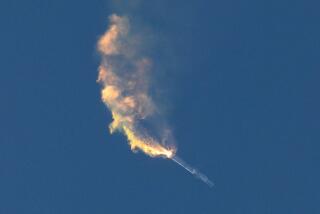Declared Fit, Shuttle Prepares to Dock With Space Station
- Share via
CAPE CANAVERAL, Fla. — An inspection of the shuttle Discovery on its second day in space showed the craft to be remarkably unblemished from its Independence Day launch -- unless you counted bird droppings.
Photographs and radar scans of the 4.5-million-pound craft showed “zero” problems, said John Shannon, deputy director of the space shuttle program.
“We don’t have very many anomalies at all,” he said during a news conference Wednesday at the Johnson Space Center in Houston.
But images taken in space did show some white splotches of what appeared to be bird droppings on one of Discovery’s wings.
The droppings were found by workers on the pad before the shuttle launched, and they somehow survived the extreme temperatures as the craft accelerated through the atmosphere into space.
Several pieces of insulating foam did come off the shuttle’s external fuel tank during launch, Shannon said. One image showed an 8-by-10-inch gap near the tank’s liquid oxygen and hydrogen fuel lines.
He said that gap represented as many as six smaller pieces, all of which came off nearly three minutes into the flight, well past the time of concern. At that point, NASA said, the shuttle was well over 200,000 feet above Earth, and the air so thin that it would not have been able to accelerate debris with the necessary force to damage the craft.
On Wednesday, Discovery’s crew unfolded a 50-foot boom with a camera on the end to survey the exterior of the craft. It found only one flaw, a protruding gap filler -- a spacer between the heat-resistant tiles -- on the underside. Shannon said the filler posed no problems in that area.
The relatively uneventful news conference Wednesday stood in contrast to the somber mood at the space agency last year during the first shuttle mission following the destruction of Columbia in 2003. Almost that entire mission consisted of dealing with potentially serious problems: the loss of a big chunk of insulating foam, the discovery of a frayed insulating blanket under a cockpit window and protruding spacers between thermal tiles that engineers feared could dangerously increase heating during reentry.
A closer inspection of the Discovery will occur today, when pilot Mark Kelly guides the orbiter through a back-flip as it docks with the International Space Station.
The maneuver will allow the space station’s crew to take pictures of the underside of the orbiter from as close as 60 feet.
More to Read
Sign up for Essential California
The most important California stories and recommendations in your inbox every morning.
You may occasionally receive promotional content from the Los Angeles Times.












